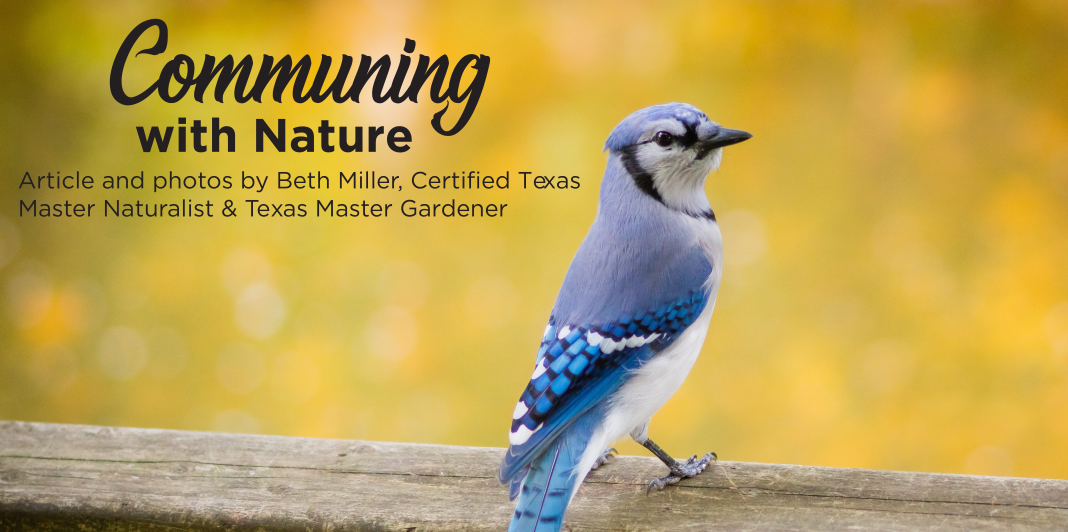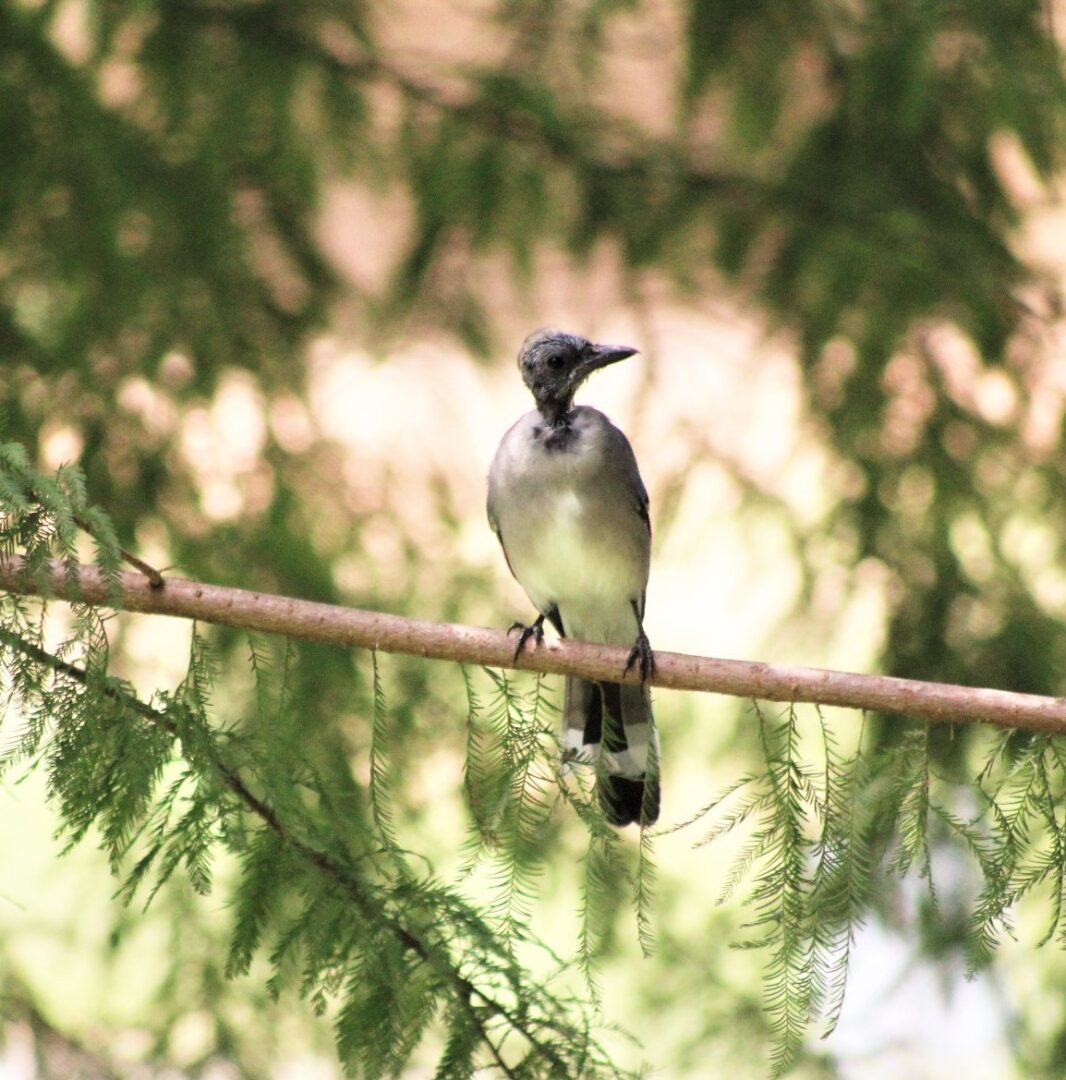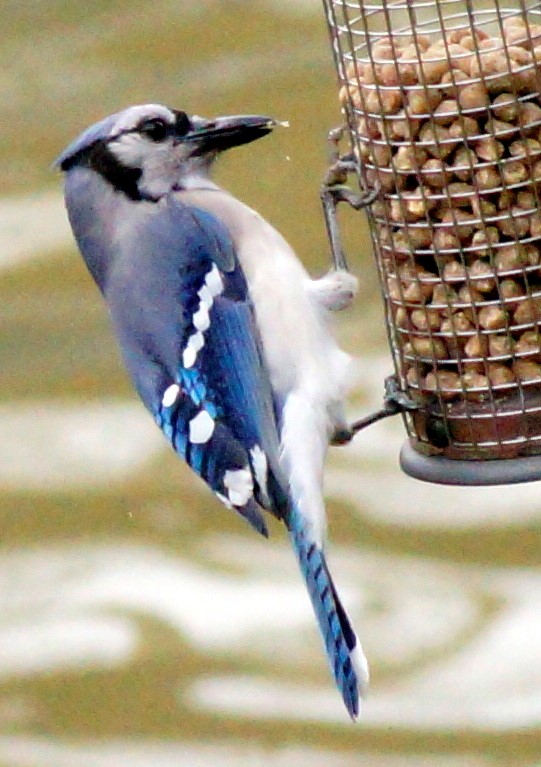What are loud, aggressive, boisterous, and blue. All are adjectives we use to describe blue jays (Cyanocitta cristata). Here in East Texas, we share our environments – urban and rural – with this bully of a bird we have all come to love, hate, or a bit of both.
Loving mates and devoted parents, it is next to impossible to tell the males from the females unless you are holding the bird for examination. Blue jays are members of the order Passeriformes, meaning a perching bird or a songbird, which includes more than half of all bird species. With a body-to-brain ratio just slightly less than a human’s blue jays are adept at problem-solving. They often work together to drive off nest or feeder raiders, often in violent attacks.
You know when they arrive at your feeder by the incredible racket, heard as they call to nearby jays. They are large birds that can hold their own with squirrels, blackbirds, and grackles, so not much drives them away.
Range and Habitat
Four species of blue jays are found throughout the Eastern and Central United States, and into South-central and Southeast Canada, classified by color, which reflects their habitat. Their ranges overlap, and natural interbreeding occurs.
- Northern blue jay: Northeastern United States and Canada.
- Coastal blue jay: North Carolina to Texas.
- Interior blue jay: Middle-United States.
- Florida blue jay: Southern Florida.
Blue jays thrive among humans year-round, especially when feeders with raw peanuts in or out of the shell and most types of sunflower seeds are available. Most of the jays in the north do migrate.
Breeding and Nesting
You can’t tell which is the male or female blue jay, but they can and they pair up for life. Mom and dad both build their nest in the springtime. Then the male gathers food for the female as she incubates their six or eight eggs which hatch out after a few weeks. Once the chicks are full grown, they fledge and begin flying with their parents learn how to feed themselves and all the tricks of being a blue jay.
Because they nest at many levels, blue jays can fall victim to predators such as snakes, hawks, and raccoons, or brood parasites such as brown-headed cowbirds that lay their eggs among the blue jay’s eggs. Generally, blue jays are not fooled, quickly recognizing, and rejecting the alien eggs.
In late summer you will likely see some scruffy, bald-headed blue jays at the feeder. Not to worry. The birds are molting and sometimes lose all the feathers on their head and many body feathers for a few weeks.
Feeding Blue Jays
Blue jays eat a variety of available foods, including acorns, berries, nuts, seeds and insects. Like squirrels, they can bury acorns, seeds, and nuts, and then remember they hid the food. Of course, not every seed is recovered, and some of them grow into trees making the blue jay an important part of the ecosystem, assisting in regenerating the forests.
Blue jays can be bullies at home feeders, taking over platform and larger tube feeders. Smaller tube feeders can make it harder for blue jays to perch, so smaller birds can eat without being pestered.
Take care not to limit feeding options too much. Putting multiple sized and types of feeders welcomes blue jays and cardinals and the small goldfinches, titmice, and chickadees so you can watch them all feed.
Blue jays cache their food like a squirrel and hide it for another time. They carry food off for storage packed in their throat in what’s called a gular pouch.
Aggressive Behaviors
Blue jays will mob hawks, owls, cats, and even humans to drive them away. In some cases, this behavior is the blue jays being protective of nests or feeders and is often beneficial to other bird species.
Communication and Mimicking
Boisterous blue jays, like mockingbirds, can mimic other bird calls and even cats, and use multiple vocalizations to communicate with other jays. They are often the first bird to sound the alarm when predators arrive on the scene. Their ability to mimic hawks drives off other animals.
Nest Predation
Baby birds of other species and eggs may be attacked and consumed in their nests. While ornithologists suggest that predation frequency among blue jays is extremely low, some birders see this as a good argument against birdfeeders.
Enjoy Blue Jay Antics
With its incredible intelligence, it can appear that blue jays clown and dance for our entertainment. Their behaviors are almost all strategic and used for protection, breeding, and communication. They show light-hearted and darker behaviors much as humans do. The facts surrounding this very common bird are interesting, and in some ways, almost human-like.
Learn more about blue jays and other frequently seen birds by joining a chapter of the Texas Master Naturalist or Texas Master Gardeners. Piney Wood Lakes Chapter of Texas Master Naturalist serves members across Polk, San Jacinto, Trinity, and Tyler Counties with volunteer opportunities, educational resources and conservation projects. txmn.org/pineywoodlakes SJC Master Gardeners serves members in San Jacinto and Polk Counties. Life-long learners and trained volunteers, master gardeners give time, knowledge, and expertise to improve the quality of life for neighbors and visitors. txmg.org/sjmg
Captions
Jay with nut: Jays are very protective of their peanuts.
Jay Molting: This sad jay is molting and has lost all its head feathers and many on the body. It only lasts a couple weeks for the new feathers to come in.
Help Me Mom: Young jays can get anxious when Mom decides they are ready to get their own food and they would rather be fed. If only we could print their racket.
Perched for Peanuts: Jays are adept acrobats as they hang onto mesh feeders.
Jays fight for peanuts: With only one peanut left in the feeder, these blue jays launched an aerial battle to determine the winner.
Jay foraging: Sometimes the blue jays go foraging under feeders, where it’s often easy to pick up seed.




















